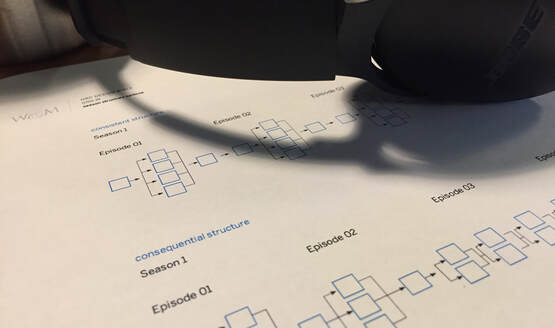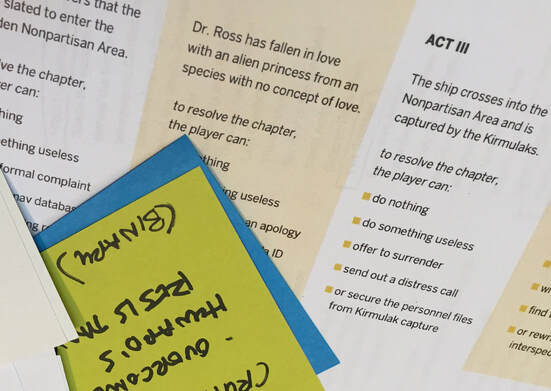|
When the idea for a game is fresh and everything is possible, it’s a good idea to start with some sort of structure — any structure really — to help you and your team get your hands around the scope and complexity of the project you’re planning. We were fortunate that HRO came with a story structure built in… Many early television writers followed a classical three act narrative structure. It usually boils down to Act I “uh oh, here’s the trouble we’re in,” then Act II “oops, the trouble just got way worse” and finally Act III “the heroes triumph over certain death.” This three-act format lent itself well to the organization of the individual stories in our branching sci-fi adventure. And, when it came time to structure the overall sweep of the game experience, we also looked back to out source material for inspiration. HRO has been put together as a “season” of “episodes” in the classical TV sense — ie without a “season arc" and in individual modular story units. This allows us to order and re-order episodes on the fly and to insert (or delete) unlockable episodes without impacting the overall flow of the experience and without the player seeing any of the behind-the-curtain juggling. Additionally, it means we can release the game with a first “season” of episodes and go back later to develop and release new content as new seasons using the same framework. Of course, we have to account for the consequences of the player’s actions. Unlike a classic TV series, characters in HRO do die, people leave the crew or are revealed as villains, and later HRO episodes need to acknowledge those variables. This has mostly been resolved through (a) a combination of avoiding calling attention to the timeline variations and (b) custom work-arounds to fill in the player-created blanks. So if an episode calls for the participation of the ship’s doctor, but for some reason the doctor is no longer on the ship, we either refocused the story so the nurse fills the doctor’s story role (avoiding the problem), or we wrote in a substitute doctor’s worth of content -- which only some of the players would see in that story (the players who caused the doctor to be absent in the first place in that earlier episode). It sounds complicated. Let’s hope it works in play testing.
0 Comments
One of the things I appreciate most about working with Eric and Worthing & Moncrieff is all the cool stuff I get to learn. As a professional in an adjacent field who was in that role for decades, I had run out of new challenges in my old career. I had a niche there. I had the skills I needed. That was pretty much it. But then Eric asked me to join him in W&M and I was delightfully at sea. Suddenly I needed to know stuff about UI design, trade show graphics, branching narratives, community engagement and dozens of other areas of competence. All new stuff for my lazy brain to work out. I love it.
Most recently, I’ve been working to improve my animation skills. Mostly with the Adobe suite of software. Adobe AfterEffects is similar enough to Adobe Illustrator — a package I have had a lot of experience using — that I grasped the underlying mechanics quickly, and then spent a ton of time trying to refine and get the software to do some cooler stuff. it’s been a wild ride. Eric and I also spent some time last year working on Rhubarb integration, which is an awesome tool. Plug in eight images of mouth position art and an audio file and Rhubarb will automatically create the mouth movements to make the text look more-or-less right. Which is way easier and less time-consuming than the more traditional methods of lip syncing. Of course, the downside of getting to learn all this new stuff is that we are sometimes ill-equipped to reasonably predict how long some of these novel tasks might actually take to perform. There are times when this lack of foreknowledge isn’t a big deal — a day or two lost here and there — and sometimes it is a big deal. Take the animation I was talking about in the last paragraph. We had allocated two months to create, animate and lip synch about 97 pages of dialogue. Which, now that we’re in the thick of it, turns out to have been wildly optimistic. So, despite good intentions, a rock-solid work ethic, a plan to streamline and re-use animation assets and the illusion of clear-headed planning, it looks like our production pipeline has temporarily gotten the better of us. This is all a long-winded way to say that we’re probably not going to meet the original projected December release date for HRO (shocked! shocked!) It’s a little disappointing, but it’s also a little exciting. Because the final product will only be richer for the extra time and care that a solid execution will give us. We hope you’ll bear with us and we look forward to keeping you updated on our progress in future posts. |
AUTHORWorthing and Moncrieff, LLC is an independent developer of video game stories founded in 2015. ARCHIVES
December 2022
|


 RSS Feed
RSS Feed
